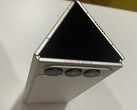The Galaxy Z Fold7 potentially represents one of the biggest upgrades for the Galaxy Z Fold series in generations. Arguably, that sentiment even factors in the Galaxy Z Fold Special Edition, whose displays the Galaxy Z Fold7 shares (curr. $1,999.99 on Amazon).
The Galaxy Z Fold7 is not free from criticism even at this early stage, though. For instance, Samsung was unable to bring S Pen support back that it dropped on the Galaxy Z Fold Special Edition. Similarly, the paltry 10 MP and 3x telephoto camera remains despite Oppo, Honor and Vivo all adopting 50 MP periscope equivalents.
Moreover, Samsung has stuck with its 4,400 mAh battery for another generation. As a result, the Galaxy Z Fold7 has the same battery capacity as the Galaxy Z Fold3 and still comes up 100 mAh short of the Galaxy Z Fold2. Meanwhile, Honor and Vivo have cracked 6,000 mAh on their foldables.
In fairness to Samsung, the Galaxy Z Fold6 lasted longer in our tests last year than the Magic V3 and X Fold3 despite featuring a significantly smaller battery than both rivals. The same cannot be said for the Oppo Find N5 though, which delivered 30% longer runtimes in our Wi-Fi battery tests than the Galaxy Z Fold6.
Consequently, we suspect the Galaxy Z Fold7 may drop to the bottom of the pack after we test it, the Magic V5 and the X Fold5. With that being said, Samsung's latest foldable may have the edge over its rivals when it comes to battery lifespan. As Ice Universe notes, the EU has certified that the Galaxy Z Fold7 should retain at least 80% of its peak battery capacity even after 2,000 charging cycles.
For context, Google will start capping the Pixel 9a's battery voltage after 200 charging cycles. Likewise, Apple rates its iPhone 16 series batteries for 1,000 cycles before reaching 80% battery health. The same goes for Motorola and the Razr 60 series too. In other words, the Galaxy Z Fold7's battery should still be trucking on well after one may consider upgrading to a future generation.
Source(s)
via Ice Universe



































